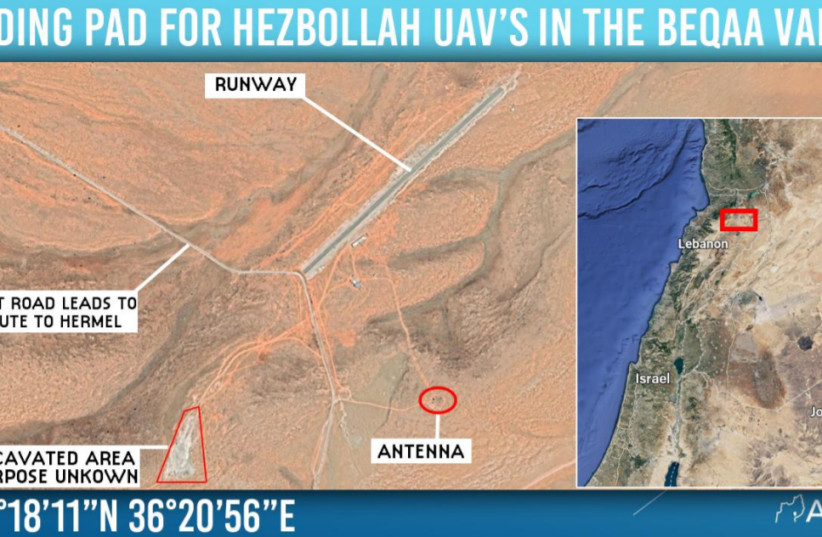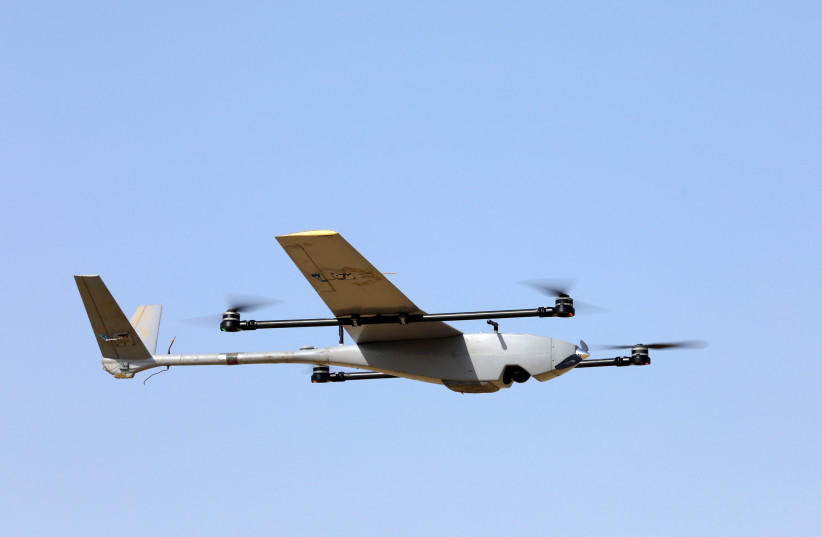Hezbollah has some 2,000 unmanned aerial vehicles, many of them advanced UAVs from Iran and others manufactured independently by the Lebanese terrorist group, a new report by the ALMA Research Center has found.
Hezbollah has been using UAVs since the 1990s and has used its drones in Syria as well as against Israel. Even before the Second Lebanon War in 2006, the group launched drones into Israel; and during the war, Hezbollah launched several armed drones into the country.
The report by ALMA listed several attempts by Hezbollah to fly its drones into Israel, including in October 2012 when a UAV launched over the Mediterranean Sea reached the Negev before it was intercepted by Israel Air Force jets.
cnxps.cmd.push(function () { cnxps({ playerId: ’36af7c51-0caf-4741-9824-2c941fc6c17b’ }).render(‘4c4d856e0e6f4e3d808bbc1715e132f6’); });
if(window.location.pathname.indexOf(“/food-recipes/”) != -1){document.getElementsByClassName(“divConnatix”)[0].style.display =”none”;var script = document.createElement(‘script’); script.src = ‘https://player.anyclip.com/anyclip-widget/lre-widget/prod/v1/src/lre.js’; script.setAttribute(‘pubname’,’jpostcom’); script.setAttribute(‘widgetname’,’0011r00001lcD1i_12258′); document.getElementsByClassName(‘divAnyClip’)[0].appendChild(script);}else if(window.location.pathname.indexOf(“/jpost-tech/”)!=-1){ document.getElementsByClassName(“divConnatix”)[0].style.display =”none”; var script = document.createElement(‘script’); script.src = ‘https://static.vidazoo.com/basev/vwpt.js’; script.setAttribute(‘data-widget-id’,’616dd69d1b04080004ac2cc0′); document.getElementsByClassName(‘divVidazoo’)[0].appendChild(script); }else if(window.location.pathname.indexOf(“/israel-news/”) == -1 &&window.location.pathname.indexOf(“/breaking-news/”)==-1 ){ document.getElementsByClassName(“divConnatix”)[0].style.display =”none”; var script = document.createElement(‘script’); script.src = ‘https://static.vidazoo.com/basev/vwpt.js’; script.setAttribute(‘data-widget-id’,’60fd6becf6393400049e6535′); document.getElementsByClassName(‘divVidazoo’)[0].appendChild(script); }
The group was said to have 200 Iranian-made UAVs in 2013; and with help from the Islamic Republic, it has since significantly increased its fleet, which is set to be used for kamikaze attacks on strategic national assets in Israel as well as reconnaissance against IDF troops and bases.
According to the report, Hezbollah “most likely” has advanced UAV models such as the Mohajer, Shahed, and Samed (KAS-04), Karrar and Saegheh types. It also possesses dozens of smaller civilian drones made by China that are used to photograph as well as to carry and drop bombs.
 Landing pad for Hezbollah UAVs in the Beqaa Valley of Lebanon (credit: ALMA RESEARCH AND EDUCATION CENTER)
Landing pad for Hezbollah UAVs in the Beqaa Valley of Lebanon (credit: ALMA RESEARCH AND EDUCATION CENTER)
Iran has been building its “UAV Army” since 1984, and the fleet not only has a significant range of over 2,000 kilometers but it has “very advanced development and operational capabilities,” the report said.
“Iran realized that it could not provide a military response throughout the Middle East in general and against Israel in particular, facing an air force operating warplanes. Therefore, it sought to develop two alternatives in recent decades: the first, a precision surface-to-surface missile system, and the second, a ‘UAV Army.’”
Though Iran has thousands of drones, the report highlighted nine types of UAVs and 48 models, including those that are operational and others that are still in trial phases. The report also discussed UAV models used by Hezbollah, Hamas and Palestinian Islamic Jihad in the Gaza Strip.
In September 2021, Defense Minister Benny Gantz said that Iran’s drone fleet “is one of the most significant tools developed by Iran.”
It’s “an array of deadly, precision weapons that, like a ballistic missile or a plane, can cross thousands of miles. The Iranians produce and export these aircraft to their proxies, in coordination with and led by the IRGC Air Force and Quds Force.”
According to Gantz, Iran is training militias from Iraq, Yemen, Lebanon and Syria to operate and manufacture Iranian UAVs at Kashan Base north of the city of Isfahan, “the cornerstone of Iranian aerial terrorism in the region.”
In addition to Kashan, the report noted more than 20 production, storage and launch sites used by Iran to launch drones from Iran, Iraq, Syria and Lebanon.
The report included Konarak Civil Airport, located east of the city of Chabahar in southern Iran, Bandar Abbas Airport, Choghadak Airfield, Gonabad Airfield, Hamedan Air Base, Jakigur Airport, Jask Airport, Kushke Airport, Marjan Airstrip, Minab Airstrip and Seman Airport.
As well as its dozens of bases in the Islamic Republic, Iran’s Revolutionary Guard Corps Quds Force uses a base near the Iraqi city of Karabala alongside Iraqi Hezbollah.
Hezbollah, the IRGC and other Shi’ite militias are also active in Syria, using several air bases to launch UAV attacks.
In Lebanon, Hezbollah has a launch site near the town of Aiiyat in the Beqaa Valley, as well as another runway several hundred meters long north of the town of Aiiyat on the outskirts of Baalbek.
“One of the key tools is UAVs and precision weapons, which can reach strategic targets within thousands of kilometers, and thus this capability is already endangering Sunni countries, international troops in the Middle East and also countries in Europe and Africa,” the defense minister said in September.
“Iran has created ‘emissary terrorism’ under the auspices of organized terror armies that help it achieve its economic, political and military goals. Iran is trying to transfer its knowledge that will enable Iraq, Syria, Lebanon and Gaza to produce advanced UAVs,” he added.
Tehran also attempted to send explosives to Palestinian terrorists in the West Bank from Syria using unmanned aerial vehicles, Gantz said.
The attempt to smuggle explosives, attached to a Shahed m141 UAV, occurred in February 2018; and while the IDF had originally said the drone was on its way to carry out a sabotage attack, “its destination was, to our understanding, terrorists in the West Bank.
“Iran is not only using unmanned aerial vehicles to attack but also to transfer weapons to its proxies,” he warned.
The Islamic Republic has designed UAVs capable of operating in a swarm, 10 or more drones. Unveiled in April, Iran developed a drone with a combat warhead weighing between 5 kg. and 15 kg. with an operational range of 400 km.
A drone and missile swarm by Iran was first used in September 2019 against Saudi Arabia’s Aramco oil processing facility in Abqaiq, some 1,000 kilometers from where the drones were launched. The attack disrupted the kingdom’s ability to produce oil for months and alerted the international community to the threat posed by Iran’s drone arsenal.
Iran has since carried out several more drone attacks, including the deadly attack on the MT Mercer Street that killed the British captain and Romanian security guard.

